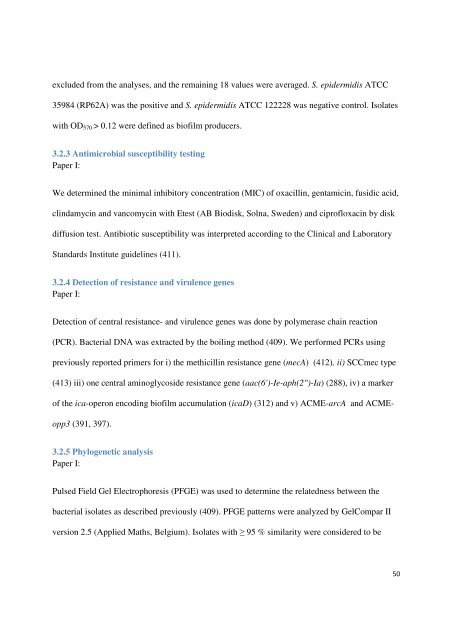Staphylococcus epidermidis - virulence factors and innate ... - Munin
Staphylococcus epidermidis - virulence factors and innate ... - Munin
Staphylococcus epidermidis - virulence factors and innate ... - Munin
You also want an ePaper? Increase the reach of your titles
YUMPU automatically turns print PDFs into web optimized ePapers that Google loves.
excluded from the analyses, <strong>and</strong> the remaining 18 values were averaged. S. <strong>epidermidis</strong> ATCC<br />
35984 (RP62A) was the positive <strong>and</strong> S. <strong>epidermidis</strong> ATCC 122228 was negative control. Isolates<br />
with OD 570 > 0.12 were defined as biofilm producers.<br />
3.2.3 Antimicrobial susceptibility testing<br />
Paper I:<br />
We determined the minimal inhibitory concentration (MIC) of oxacillin, gentamicin, fusidic acid,<br />
clindamycin <strong>and</strong> vancomycin with Etest (AB Biodisk, Solna, Sweden) <strong>and</strong> ciprofloxacin by disk<br />
diffusion test. Antibiotic susceptibility was interpreted according to the Clinical <strong>and</strong> Laboratory<br />
St<strong>and</strong>ards Institute guidelines (411).<br />
3.2.4 Detection of resistance <strong>and</strong> <strong>virulence</strong> genes<br />
Paper I:<br />
Detection of central resistance- <strong>and</strong> <strong>virulence</strong> genes was done by polymerase chain reaction<br />
(PCR). Bacterial DNA was extracted by the boiling method (409). We performed PCRs using<br />
previously reported primers for i) the methicillin resistance gene (mecA) (412), ii) SCCmec type<br />
(413) iii) one central aminoglycoside resistance gene (aac(6')-Ie-aph(2")-Ia) (288), iv) a marker<br />
of the ica-operon encoding biofilm accumulation (icaD) (312) <strong>and</strong> v) ACME-arcA <strong>and</strong> ACMEopp3<br />
(391, 397).<br />
3.2.5 Phylogenetic analysis<br />
Paper I:<br />
Pulsed Field Gel Electrophoresis (PFGE) was used to determine the relatedness between the<br />
bacterial isolates as described previously (409). PFGE patterns were analyzed by GelCompar II<br />
version 2.5 (Applied Maths, Belgium). Isolates with ≥ 95 % similarity were considered to be<br />
50
















